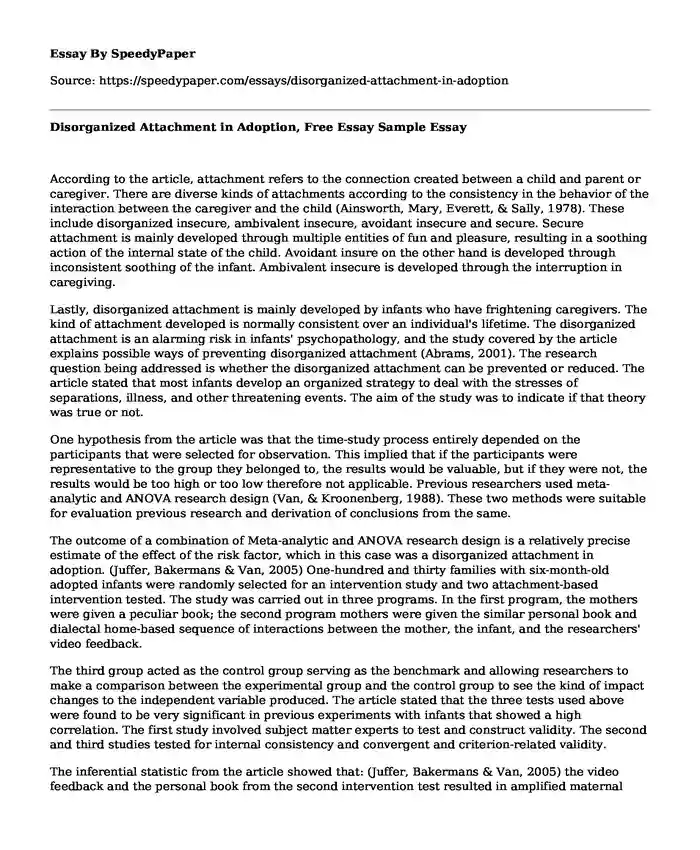
| Type of paper: | Essay |
| Categories: | Psychology Parenting |
| Pages: | 4 |
| Wordcount: | 842 words |
According to the article, attachment refers to the connection created between a child and parent or caregiver. There are diverse kinds of attachments according to the consistency in the behavior of the interaction between the caregiver and the child (Ainsworth, Mary, Everett, & Sally, 1978). These include disorganized insecure, ambivalent insecure, avoidant insecure and secure. Secure attachment is mainly developed through multiple entities of fun and pleasure, resulting in a soothing action of the internal state of the child. Avoidant insure on the other hand is developed through inconsistent soothing of the infant. Ambivalent insecure is developed through the interruption in caregiving.
Lastly, disorganized attachment is mainly developed by infants who have frightening caregivers. The kind of attachment developed is normally consistent over an individual's lifetime. The disorganized attachment is an alarming risk in infants' psychopathology, and the study covered by the article explains possible ways of preventing disorganized attachment (Abrams, 2001). The research question being addressed is whether the disorganized attachment can be prevented or reduced. The article stated that most infants develop an organized strategy to deal with the stresses of separations, illness, and other threatening events. The aim of the study was to indicate if that theory was true or not.
One hypothesis from the article was that the time-study process entirely depended on the participants that were selected for observation. This implied that if the participants were representative to the group they belonged to, the results would be valuable, but if they were not, the results would be too high or too low therefore not applicable. Previous researchers used meta-analytic and ANOVA research design (Van, & Kroonenberg, 1988). These two methods were suitable for evaluation previous research and derivation of conclusions from the same.
The outcome of a combination of Meta-analytic and ANOVA research design is a relatively precise estimate of the effect of the risk factor, which in this case was a disorganized attachment in adoption. (Juffer, Bakermans & Van, 2005) One-hundred and thirty families with six-month-old adopted infants were randomly selected for an intervention study and two attachment-based intervention tested. The study was carried out in three programs. In the first program, the mothers were given a peculiar book; the second program mothers were given the similar personal book and dialectal home-based sequence of interactions between the mother, the infant, and the researchers' video feedback.
The third group acted as the control group serving as the benchmark and allowing researchers to make a comparison between the experimental group and the control group to see the kind of impact changes to the independent variable produced. The article stated that the three tests used above were found to be very significant in previous experiments with infants that showed a high correlation. The first study involved subject matter experts to test and construct validity. The second and third studies tested for internal consistency and convergent and criterion-related validity.
The inferential statistic from the article showed that: (Juffer, Bakermans & Van, 2005) the video feedback and the personal book from the second intervention test resulted in amplified maternal responsiveness with (d=.65). The infants involved in this second study were less likely to be classified as suffering from disorganized attachment at the age of twelve months with (d=.46) and took possession of lower scores on the rating scale as compared to children in the control group with (d=.62). In the first intervention test, where the mothers were given the personal book only, the children showed lower disorganization as compared to the benchmarking group, but there were no effects on the numerical value of infants with disorganized attachment classification observed (Ainsworth, Bell, & Stayton, 1974). It was noted that the study did not support the inference.
Conclusion
In conclusion, the study showed that there was a direct solution to disorganized attachment in adoption. The rate was not too low or too high. The short-term preventive intervention program with the video feedback and a personal book lowered the rate of disorganized attachment (Juffer, Bakermans & Van, 2005). The effectiveness of this study was to show the importance of parenting in the development of infant attachment disorganization. It is therefore essential to note that the attachment style an individual develops as an infant will be unchanged during their lifetime unless the individual intentionally tries to change that kind of attachment pattern.
References
Abrams, K.Y.(2001). Pathways to disorganization: A study concerning varying types of parental frightened and frightening behaviors as related to infant disorganized attachment.
Ainsworth, M. D. S., Bell, S. M., & Stayton, D. F (1974). Infant-mother attachment and social development: Socialization as a product of reciprocal responsiveness to signals.
Ainsworth, Mary DS, Mary C. Blehar, Everett Waters, and Sally Wall. "Patterns of attachment: assessed in the strange situation and at home."(1978)
Juffer, F., Bakermans- Kranenburg, M. J., & Van IJzendoorn, M. H. (2005). The importance of parenting in the development of disorganized attachment: Evidence from a preventive intervention study in adoptive families. Journal of Child Psychology and Psychiatry, 46(3), 263-274.
Van Ijzendoorn, M. H., & Kroonenberg, P. M. (1988). Cross-cultural patterns of attachment: A meta-analysis of the strange situation. Child development, 147-156.
Cite this page
Disorganized Attachment in Adoption, Free Essay Sample. (2022, Sep 09). Retrieved from https://speedypaper.net/essays/disorganized-attachment-in-adoption
Request Removal
If you are the original author of this essay and no longer wish to have it published on the SpeedyPaper website, please click below to request its removal:
- Case Study on Word of Mouth Marketing
- Immigration Research Paper Sample
- Existence of God - Research Paper Example
- Free Essay on Budgeting Money
- Free Essay on Accounting Information Systems Relating to Sales Transactions
- Essay Sample Comparing Healthcare Systems of US and Great Britain
- Essay Sample on the Role of Sanctuary Cities and Trump's Policies on the Immigration
Popular categories




